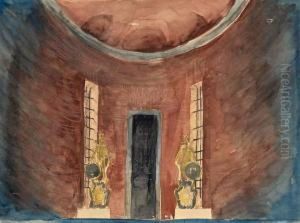Oskar Strnad Paintings
Oskar Strnad was an Austrian architect, stage designer, and interior designer, whose work left a significant mark on the Viennese art scene of the early 20th century. Born on September 23, 1879, in Vienna, Austria, Strnad was a pivotal figure in the development of modernist architecture and design in Vienna, contributing to the city's cultural and artistic identity during a period of rich innovation and transformation. His career was deeply intertwined with the Vienna Secession movement, and later with the Werkstätte, reflecting a broader shift towards modernism across Europe. Strnad's work was characterized by a unique blend of functionalism and ornamentation, aiming to create spaces and objects that were both beautiful and practical.
Strnad received his education at the Technische Hochschule in Vienna, where he was influenced by the teachings of Otto Wagner, a leading architect of the time known for his progressive views on architecture. This education laid the foundation for Strnad's innovative approach to design, emphasizing clarity, simplicity, and the integration of architecture with its environment. Throughout his career, Strnad worked on a wide range of projects, including residential buildings, interior designs, and stage sets for theaters, demonstrating his versatility and creative vision.
One of Strnad's most notable contributions to architecture and design was his advocacy for a holistic approach to creating living spaces, which involved the integration of architecture, furniture design, and decorative arts. This approach was evident in his interior design projects, where he meticulously designed every detail, from furniture and lighting to textiles and wall decorations, to create harmonious and functional living environments. His designs often featured a mix of traditional and contemporary elements, reflecting his belief in the importance of bridging the past with the future.
Strnad's work in stage design also showcased his innovative spirit. He designed sets for numerous productions in Vienna, bringing a new level of artistic and conceptual sophistication to theatrical presentations. His sets were known for their dynamic compositions and ability to enhance the narrative and emotional depth of the performances. This work not only solidified his reputation as a versatile artist but also contributed to the evolution of stage design as an art form.
Despite his significant contributions to architecture and design, Oskar Strnad's work was not widely recognized outside of Austria until after his death on September 3, 1935. In recent years, however, there has been a growing appreciation of his achievements, with exhibitions and publications celebrating his legacy as a pioneer of modernist design. Strnad's career is now seen as emblematic of the creative fervor that defined Vienna in the early 20th century, and his work continues to inspire architects and designers around the world.

